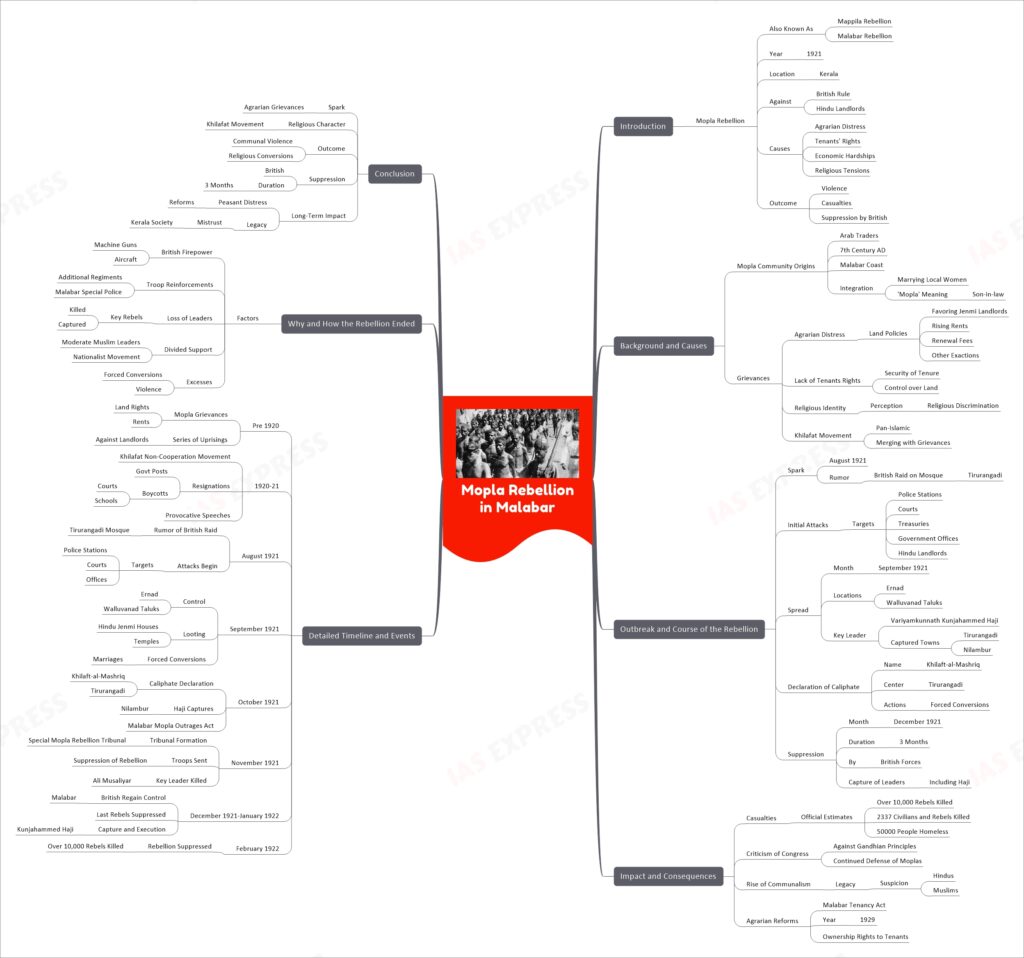Mopla Rebellion 1921: Causes, Events, Impacts
The Mopla Rebellion, also known as the Mappila Rebellion or Malabar Rebellion, was an armed uprising in 1921 by Mappila Muslims of Kerala against British colonial rule and Hindu landlords in the Malabar region. It was sparked by agrarian distress, tenants’ rights issues, economic hardships, and religious tensions. The rebellion led to violence and casualties on both sides before being suppressed by British forces.
Background and Causes
The Mopla community traces its origins to Arab traders who came to the Malabar coast of Kerala in the 7th century AD and married local women, giving rise to the name ‘Mopla’ meaning son-in-law. Over the centuries, the Moplas developed grievances over land rights and economic hardships:
- Agrarian distress and land policies: British land tenure policies favored Jenmi landlords resulting in rising rents, renewal fees and other exactions faced by Mopla tenant farmers. This caused economic hardship and distress.
- Lack of tenants rights: Mopla tenants lacked security of tenure or control over the land they tilled, reducing them to landless laborers.
- Religious identity: Policies seen as favoring Hindu landlords led to a perception of religious discrimination among the Mopla Muslim community.
- Khilafat Movement: The pan-Islamic Khilafat movement merged with the existing Mopla grievances, giving the struggle a religious color.
The agrarian distress and tenants rights issues combined with the Khilafat movement stirred up resentment that ultimately manifested in the form of the violent rebellion.
Outbreak and Course of the Rebellion
The Mopla rebellion broke out in August 1921, sparked by rumors that British officials had raided a mosque in Tirurangadi:
- Initial attacks: Mopla mobs began attacking police stations, courts, treasuries and government offices. Hindu landlords were also targeted.
- Spread of rebellion: By September 1921, the rebellion had spread across Ernad and Walluvanad taluks. The key leader Variyamkunnath Kunjahammed Haji captured the towns of Tirurangadi and Nilambur.
- Declaration of caliphate: The rebels declared the ‘Khilaft-al-Mashriq’ or the Caliphate of the East centered in Tirurangadi. Several Hindus were forcibly converted to Islam.
- Suppression: By December 1921, after 3 months of rebel control, the uprising was brutally suppressed by British forces. Key leaders including Haji were captured.
The rebellion led to the destruction of many Hindu temples, churches and homes along with forcible conversions and casualties on both sides before being quelled by the British after 3 months.
Impact and Consequences
The Mopla rebellion had significant short-term and long-term consequences:
- Casualties: Official estimates note over 10,000 rebels killed by the British along with 2337 rebels and civilians killed by the Mopla mobs. Almost 50000 people were left homeless.
- Criticism of Congress: The rebellion was criticized as going against Gandhian principles of non-violence. But the Congress party continued to defend the Moplas.
- Rise of communalism: The violence and religious conversions led to a legacy of suspicion between Hindus and Muslims of Malabar. It contributed to the rise of communal politics over time.
- Agrarian reforms: The peasant distress behind the uprising led to the Malabar Tenancy Act of 1929 granting ownership rights to tenants.
The Mopla rebellion remains a controversial event in Kerala’s history. While sparked by agrarian grievances, the religious violence has also left a contested legacy in its wake.
Detailed Timeline and Events
A more detailed timeline of major events in the Mopla rebellion:
- Pre 1920
- Mopla grievances over land rights and rents under British policies
- Series of Mopla uprisings against landlords in 19th and early 20th century
- 1920-21
- Khilafat Non-Cooperation movement spreads in Malabar
- Moplas resign from govt posts, boycott courts and schools
- Seeds of rebellion sown through provocative speeches
- August 1921
- Rumors of British raid on Tirurangadi mosque
- Mopla mobs begin attacks on police stations, courts and offices
- September 1921
- Rebels take control of Ernad and Walluvanad taluks
- Looting of Hindu Jenmi houses and temples
- Forced conversions and marriages
- October 1921
- Rebels declare ‘Khilaft-al-Mashriq’ caliphate at Tirurangadi
- Variyamkunnath Kunjahammed Haji captures Nilambur
- British pass Malabar Mopla Outrages Act
- November 1921
- Special Mopla Rebellion tribunal formed
- British troops sent to suppress rebellion
- Key rebel leader Ali Musaliyar killed
- December 1921-January 1922
- British regain control of Malabar
- Last rebel bands suppressed
- Capture and hanging of Variyamkunnath Kunjahammed Haji
- February 1922
- Rebellion completely suppressed
- Over 10,000 Mopla rebels killed by British
Why and How the Rebellion Ended
The Mopla rebellion ultimately failed and was brutally suppressed due to a combination of factors:
- British firepower: The British brought in superior firepower including machine guns and aircraft that outgunned the rebel forces.
- Troop reinforcements: Additional British regiments and even the Malabar Special Police were brought in from other areas to augment forces.
- Loss of leaders: Many top rebel leaders including Ali Musaliyar and Kunjahammed Haji were killed or captured in late 1921 weakening the rebel command structure.
- Divided support: The rebellion did not receive support from moderate local Muslim leaders or the nationalist movement allowing the British to isolate the hardline rebels.
- Excesses: Cases of forced conversions and violence alienated local Hindus who had initially supported the anti-British struggle.
Faced with additional troop reinforcements, loss of leaders and supplies, the rebels were defeated in detail across Malabar by end of December 1921, allowing British authority to be re-established by early 1922.
Conclusion
In conclusion, the Mopla rebellion of 1921 was sparked by agrarian grievances but took on a religious character due to the Khilafat movement, resulting in communal violence and religious conversions before being brutally put down by the British after 3 months. While the peasant distress fueling it led to some reforms, the legacy of mistrust from the religious violence continued to impact Kerala’s society in the long-term.


